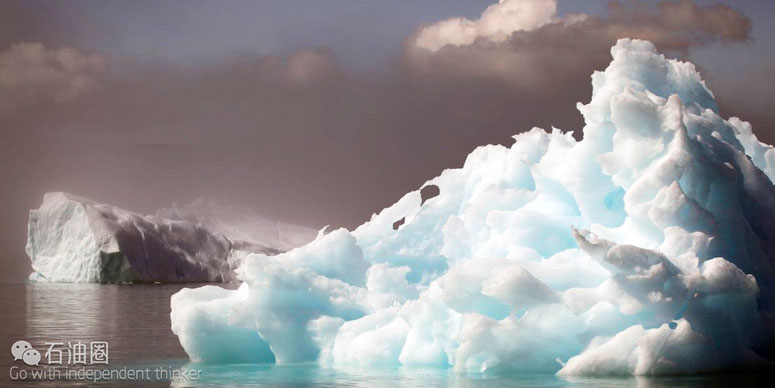
据悉,俄罗斯2016年油气发现量大幅下降,专家们预测,俄油气或支撑不到2050年!俄罗斯“油气霸主”之路还能走多远?
作者 | Viktor Katona
编译 | 莹莹
2015年全球钻探活动减少了20%,而2016年下降了更多。2016年全球常规油气发现量为37亿桶,该数值仅能支撑全球45天的原油消耗或仅占全球已探明储量的0.2%,处于自1952年以来的最低水平,其中俄罗斯勘探开发活动最受影响。
油价下跌、目标制裁,俄罗斯油气业在过去几年里一直遭受着双重打击。2014年制裁前,俄最大油气发现Pobeda储量约为原油1.3亿吨,天然气5千亿立方米;而在2015年制裁后,俄罗斯仅有7处油气发现,其中3处位于波罗的海;2016年,虽然俄油企共发现40处远景油气区,但其中最大的Nertsetinskoye油气区的3P储量也仅为1740万吨,制裁前后的情况形成了鲜明对比。
俄罗斯的石油什么时候会用光?
当石油开始走下坡路,俄罗斯是否能继续位列顶级产油国之列?俄罗斯油气复苏能否持续? 该国自然资源与环境保护部门表示,不考虑新油气发现,当前俄石油储量为290亿吨。
以当前消耗率来计算,俄石油将在2044年耗尽,2P气体储量耗尽将在此基础上推迟160年。对此,俄政府应适当放宽商业政策,如放宽许可证发放政策、增加500平方千米的底土区块面积等。然而,事实是俄罗斯现仍有大量未开发油气储备,政府的激励措施不应与之混淆。那么这些储备在哪?
主要产油区更迭
俄罗斯的原油未来将更多考虑油价、地质复杂程度和传统产油区更迭等因素。2004 – 2005年,西西伯利亚产能从71%降至57%,1970年代,正如西西伯利亚取代了苏维埃政权时期主要的生产地Volga-Urals区域一样,如今东西伯利亚和近海地区又将取代西西伯利亚区域。
早在1990年代,由于石油采收率降低及富油区发展速度低于预期,西西伯利亚的产油量一直被预测要走下坡路,因此,俄对主要产油区更迭似乎并不感到意外,但俄油气业似乎一直在被分析家们所蒙蔽。从1980年代初开始,分析师们就预测俄产油量将下滑。虽然在1996-1999年该国产油量确实减少了,年产油量仅为301-305亿吨,但造成这一现象的主要原因是由于该国整体的经济萧条,而不是所谓的资源缺乏。
俄罗斯在常规油气领域的技术已然成熟,但在非常规领域却不尽然。目前来看,俄油企似乎对页岩、北极油层和深水项目等非常规项目不那么得心应手,仍需引进西方的非常规油气开采技术。因此,美国和欧盟针对俄罗斯实施的技术制裁似乎并不是巧合,但制裁并不能长期限制俄罗斯北极勘探活动。
非常规领域或成未来主战场
北极油层
俄罗斯北极大陆架蕴含丰富油气资源,大约占其未探明储量的60%。Kara海域蕴含大量天然气,该领域是自1983年Murmanskoye气田(1200亿立方米)以来的又一天然气田发现。北部Barents海域最近也相对活跃,俄联邦土地管理局认为,未来几年该海域或能发现顶级油气藏。目前为止,俄北极大陆架3P储量为原油5.85亿吨,天然气10.4万亿立方米,但其绝大部分北极油气资产仍处于粗略评估状态。
西方油企应意识到,俄政府视北极油层为“国家意义”上的资源,因此俄不可能将该地区资源股份化。在北极油层,Laptev和Chukchi海域目前还没有进行大规模评估,但对这种投资风险较大的油层,政府也会留有相对自由的开发空间。此外,在联合国大陆架界限委员会承认Okhotsk海域为俄罗斯飞地后,该区域也可以进行考察和评估了。
未来40-50年,北极大陆架、Timano-Pechora盆地和Yenisey-Khatanga盆地将为俄罗斯维持全球前三大产油国的地位发挥至关重要的作用。此外,俄罗斯油气发展不仅与北极油气资源有关,其也将依靠非常规油气——页岩。
页岩油气
就目前统计数据来看,俄罗斯页岩储备仅次于美国,位居全球第二。俄Bazhenov区块占地100万平方千米,是全球最大的页岩沉积层,预计其致密油储量将达到200亿吨,但目前其开发尚处起步阶段,若此类稠油层得到合理开发,俄将轻而易举打败其竞争对手。此外,Abalak区块覆盖了Volga-Urals大部分地区,虽然该区块目前仍难以进行评估,但其位于传统油气生产区,拥有完备的油气基础设施。但即使俄页岩储备充足,其发展却仍需面临诸多因素阻碍。
传统油气盈亏平衡值为20-30美元/桶,而俄罗斯致密油则需油价至少维持在55-60美元/桶,这就会在一定程度上阻碍俄非常规油气的发展。
虽然俄页岩油气发展滞后于美国,但这也不见得是一件坏事。预计在“进口替代”政策的支持下,到2020年代,俄油服公司也许能充分利用页岩补贴,并于2000年代末期,在时间、钻井成本及作业效率方面超越其竞争对手美国。到那时,也许反俄制裁将只是过去的一个“玩笑”。
常规油气仍存实力
最后,油气业也不要低估俄罗斯常规油气储备,近年来,由于油气采收技术不断提高,使得该国仍需大规模勘探活动。Astrakhan Oblast州发现了原油储量3.3亿吨的Velikoye油田,而这一发现也直接证明了该国的能源实力。
到2044年,俄油气储备是否会真的耗尽?对于这一尚未发生的事,俄罗斯自然能源部无法给出明确回答,且这一说法也仅仅反映了一种固有的保守主义,而不是该国真正的实力。二十一世纪,俄罗斯将仍是全球主要产油国,该国产油中心也将进一步向东北部、深水和盐下区转移,当然,成本也会进一步提高!
On a global level, 2015 and 2016 marked the lowest level of new conventional oil discoveries since 1952. In 2016, only 3.7 billion barrels of conventional oil were discovered, roughly 45 days of global crude consumption or 0.2 percent of global proved reserves. Globally, exploratory drilling fell by almost 20 percent in 2015 and fell even further in 2016. Russia’s exploration activities, which were hit not only by plummeting oil prices but also by a targeted sanctions regime, suffered a double blow during this period. In 2015, only seven new hydrocarbon discoveries were made in Russia, three of them in the Baltic Sea. In 2016, oil and gas companies in Russia discovered 40 prospective fields, however, the 3P reserves of the largest among them, Rosneft’s Nertsetinskoye, amounted to 17.4 million tons. This stands in stark contrast with pre-sanction period achievements, for instance, 2014’s largest find, Pobeda, is believed to contain 130 million tons of oil and 0.5TCm of gas.
It is only logical that against such depressive trends, that people start to question the sustainability of Russia’s current oil-producing renaissance (Graph 1). When will Russia run out of oil? Were Sheikh Yaki Zamani’s “Stone age” simile to materialize, would Russia still be among the top producers when oil started its descent towards obsolescence?
The Ministry of Natural Resources and Environmental Protection of Russia states that not accounting for new discoveries, current oil reserves in Russia stand at 29 billion tons and under current consumption rates would be depleted by 2044 (its 2P gas reserves’ depletion would come about in more than 160 years). To this end, it would like to implement business-easing measures, e.g.: facilitate the issuance of licenses and to increase the size of the allotted subsoil block to a maximum of 500 km2 (which would mean a fivefold increase compared to existing regulations). The Ministry’s stimulating measures, however, should not obfuscate the fact that Russia still has vast amounts of untapped reserves waiting to be discovered. But where?
The future of Russian crude lies in oil that is more expensive, more geologically complex and further away from traditional regions of production. Just as West Siberia replaced the Volga-Urals Region in the 1970s as the Soviet Union’s main producing region, East-Siberia and offshore regions will overtake West-Siberia (which saw its share in the national output diminish from 71 percent in 2004-2005 to 57 percent currently). This change of “leaders” is long overdue as West-Siberia oil output was already expected to plummet in the 1990s, yet thanks to extended oil recovery methods and slower-than-expected development of other oil-rich regions it has managed to keep stable output numbers. Russia’s oil sector has been consistently hoodwinked by analysts, who, beginning from the early 1980s predicted an imminent production slump. The production fall did happen, reaching a low-point between 1996 and 1999 when production foundered to 301-305 million tons per year. The cause was to be sought in Russia’s overall economic depression, not in its dearth of resources.
Today, Russian companies are similarly constrained in tackling Russia’s three new oil frontiers – shale, Arctic and deep-water. It is no coincidence that U.S. and EU sanctions targeted the sales of technologies related to these sectors and not conventional – whilst Russian companies are well-equipped to deal with conventional fields, they relied heavily on Western know-how. Yet it is very unlikely that even a tightening of sanctions could stall Russia’s Arctic exploration activities for a longer period of time.
Russia’s continental shelf contains most of the Arctic’s oil formations and approximately 60 percent of its undiscovered reserves. So far, the 3P reserves of Russia’s Arctic stand at 585 million tons and 10.4 TCm, yet most of its Arctic Seas were only superficially appraised. The Kara Sea, whose fields are almost exclusively gaseous, has been in the spotlight since the 1983 of the Murmanskoye gas field (120 BCm), yet the northern parts of the adjacent Barents Sea, which Russia’s Federal Agency on Subsoil Usage deems the most likely to yield top hydrocarbon discoveries in the next few years, are relative newcomers in prospective surveys.
Western oil & gas companies should be aware that the Russian government treats Arctic formations as resources of “federal significance” and it is unlikely to provide them a role other than that of a minority shareholder. There is more maneuvering room for oil formations in the riskier part of the Arctic – the as of yet impossible-to-assess Laptev and Chukchi Seas, where no large-scale surveying has been done. Moreover, after the UN Commission on the Limits of the Continental Shelfacknowledged the Okhotsk Sea as a Russian enclave, the least-researched Russian sea can now be prospected and appraised. Still, the Russian Arctic, along with frontier zones like the Timano-Pechora Basin and the Yenisey-Khatanga Basin, will play an important role in keeping Russia among world’s top 3 oil producers in the next 40-50 years. Yet there is more, Russia’s oil future is not only more Arctic, but also more shale-related.Related: Putin Seeks Greater Influence in Central Asia
Russia has been sitting on vast shale/tight oil reserves, which according to present data are second only to the United States. Yet it might easily surpass all its rivals, as the development of gigantic tight-oil formations, such as Bazhenov Suite, the largest shale deposit in the world covering a territory of more than 1 million km2 and assumed to contain at least 20 billion tons of oil, is still in its infant phase. The potential of the Abalak Suite underlying the Bazhenov, the Domanik Suite, stretching asymmetrically across the Volga-Urals Region from Perm to Orenburg, as well as many others, is still difficult to assess, yet virtually all of them are located in traditional oil-producing regions with a fully-established oil infrastructure. Although the first Bazhenov oil gush dates back to 1969, several factors have hindered the development of Russian tight oil, yet the principal among them was the availability of other, less-costly variants of production. The preference for easier-to-access, less costly formations is aptly reflected in Russia’s curbing of deep-hole exploration drilling (Graph 1).
As Russia’s tight oil needs at least an oil price level of 55-60 USD per barrel, bringing the first fields on-stream is still some way off as conventionals’ breakeven levels are in the 20-30 USD per barrel range. Despite a significant lag compared to the U.S. shale revolution, this might not be that unfavorable for Russia. It is expected that under the aegis of “import substitution”, Russian service companies might be fully up to the task to exploit Russia’s shale bounty by the 2020s, moreover, they are likely to work in an environment with significantly lower drilling costs, time and efficiency rates than their American counterparts in late 2000s (thus yielding more oil). By that time, perhaps, anti-Russian sanctions will be a yesteryear affair.
Lastly, one should not underestimate the tenacity of Russia’s conventional oil reserves, which thanks to enhanced oil recovery techniques and supplementary exploration will remain a force to be reckoned with. As demonstrated by the discovery of the Velikoye field in the Astrakhan Oblast (reserves estimated at 330 million tons of oil), Russia’s pre-salt layers, even in regions previously thought to be on the verge of depletion, might kickstart a new development vector in its energy matrix. As Russia’s Natural Resource Ministry cannot account for events that are still yet to happen, its 2044 depletion assumption reflects merely its inherent conservatism, not the country’s realistic capabilities. By all accounts, Russia will remain a major oil-producing nation throughout the entire XXIst century, with oil production moving to places that are further (north and east), deeper (both deepwater and pre-salt) and generally more costly.
未经允许,不得转载本站任何文章:
-

- 阿佳徐
-
石油圈认证作者
- 毕业于黑龙江大学英语口译专业,具有丰富的翻译工作经验。致力于观察国际油气行业动态,能够快速、准确传递油气行业最新资讯,提供丰富的油气信息,把握行业动向,为国内企业提供专业的资讯服务。(QQ:348418756)


 石油圈
石油圈
